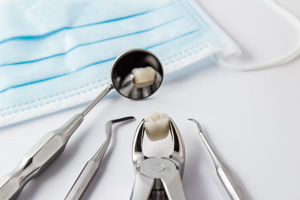 We try to save teeth when at all possible. When a tooth is so damaged it cannot be saved, an extraction may be the best option. Situations when extractions may be recommended include; teeth that are fractured below the gumline, severe tooth decay, advanced periodontal disease, primary (baby) teeth that are crowded or not falling out properly, impacted wisdom teeth.
We try to save teeth when at all possible. When a tooth is so damaged it cannot be saved, an extraction may be the best option. Situations when extractions may be recommended include; teeth that are fractured below the gumline, severe tooth decay, advanced periodontal disease, primary (baby) teeth that are crowded or not falling out properly, impacted wisdom teeth.
Simple vs. Surgical Extractions
When the tooth is visible above the gumline, Dr. Fernandez or Dr. Cox will perform a simple extraction. If the tooth is below the gumline requiring the removal of gum tissue or bone during the procedure, a surgical extraction is necessary. If the tooth breaks off during a simple extraction procedure, the simple extraction may become a surgical extraction.
The Procedure
Dr. Fernandez or Dr. Cox will numb the area with anesthetic and will ensure the area is completely numb before beginning the procedure. If a surgical extraction is necessary, the doctor will make a small incision in the gum. An instrument called an elevator is used to gently loosen the tooth. Forceps are then used to grip the tooth and carefully remove it.
Post-Op Care
During the first 24 hours, it is important that a blood clot form on the extraction site to stop bleeding, reduce pain and speed healing. The following directions are important to follow:
During the first 24 hours:
- Bite on gauze pad firmly for the first 30-60 minutes. Some oozing is normal and blood mixes with saliva which can make it look like it is bleeding more than it really is. If oozing is significant after 1 hour, repeat with a clean gauze pad. The site could ooze for as long as 24 hours.
- To help with discomfort, take the pain medication before the anesthetic has completely worn off or as directed.
- To keep swelling to a minimum, put an ice pack on your face, 20 minutes on and 20 minutes off.
- When the numbness wears off, drink lots of lukewarm or cold fluids and eat only soft foods, chewing on the opposite side of the mouth.
- Don’t spit, suck candies or suck through a straw.
- Don’t rinse your mouth and don’t brush or floss next to the extraction site.
- Don’t smoke or use tobacco for at least 72 hours because it slows healing.
- Avoid sneezing or coughing if possible.
- Limit yourself to calm activities and elevate your head when lying down to reduce bleeding.
- Don’t drink hot, carbonated or alcoholic drinks and avoid hot or spicy foods.
After 24 hours:
- Begin eating normally as soon as it’s comfortable.
- Resume brushing and flossing your teeth. Be gentle around the extraction site.
- If antibiotics were prescribed, continue to take them as directed, even if infection seems to be gone.
- Reduce soreness and swelling by applying moist heat. Swelling usually subsides after 48 hours.
- If swelling persists, rinse very gently with warm salt water, one teaspoon of salt per glass of warm water.
- Rinse 2-3 times per day for a week following the extraction.
When to Call Us
Please call us if you have any questions. We are here to help! It is normal to have some discomfort for several days following an extraction. Please call immediately if you have any of the following:
- Continued heavy or increased bleeding.
- Pain or swelling that continues or increases beyond 2-3 days.
- Bad taste or odor in your mouth.
- Reaction to the medication.

